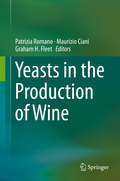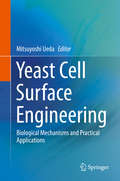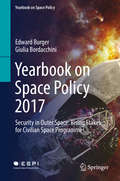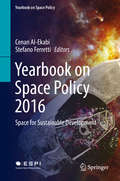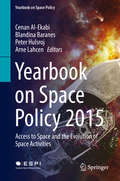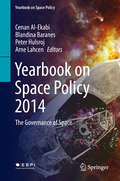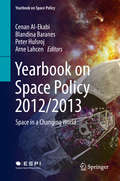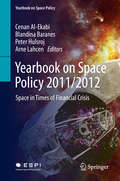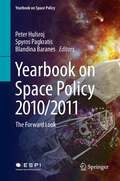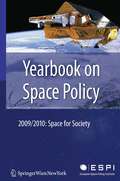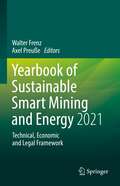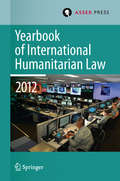- Table View
- List View
Yellow Biotechnology I: Insect Biotechnologie in Drug Discovery and Preclinical Research (Advances in Biochemical Engineering/Biotechnology #135)
by Andreas VilcinskasUtility of Insects for Studying Human Pathogens and Evaluating New Antimicrobial Agents, by Yan Wang, De-Dong Li, Yuan-Ying Jiang and Eleftherios Mylonakis. Galleria Mellonella as a Model Host to Study Gut Microbe Homeostasis and Brain Infection by the Human Pathogen Listeria Monocytogenes, by Krishnendu Mukherjee, Ramya Raju, Rainer Fischer and Andreas Vilcinskas. Drosophila as a Model to Study Metabolic Disorders, by Julia Hoffmann, Renja Romey, Christine Fink and Thomas Roeder. The Fruit Fly Drosophila melanogaster as a Model for Aging Research, by Annely Brandt and Andreas Vilcinskas. Drosophila and the Hallmarks of Cancer, by Theodoulakis Christofi and Yiorgos Apidianakis. The red flour beetle Tribolium castaneum as a model to monitor food safety and functionality, by Stefanie Grünwald, Iris V. Adam, Ana-Maria Gurmai, Ludmila Bauer, Michael Boll, and Uwe Wenzel. Identification and Bioanalysis of Natural Products from Insect Symbionts and Pathogens, by Alexander O. Brachmann and Helge B. Bode. Antiparasitic Peptides, by Jette Pretzel, Franziska Mohring, Stefan Rahlfs and Katja Becker.
Yellow Alkaline Noodles: Processing Technology and Quality Improvement (SpringerBriefs in Food, Health, and Nutrition)
by Roselina Karim Muhammad Tauseef SultanThis Brief will provide an overview of various types of noodles with special emphasis on yellow alkaline noodles. It includes detailed discussions about yellow alkaline noodles including their ingredients, processing technology, the factors affecting their nutritional value and quality. Recent developments and potential ways of improving ingredient quality and enhancing their shelf life are the hallmark of this Springer brief. Noodles are one of the oldest forms of processed foods and they comprise an important part of the diet of various Asian countries, and are popular world-wide. Yellow alkaline noodles specifically are the preferred noodle of Southeast Asia (e.g., China, Indonesia, Malaysia, and Thailand, Japan and Korea) and accounts for ~30% wheat flour consumption in some countries.
Yeasts in the Production of Wine
by Patrizia Romano Maurizio Ciani Graham H. FleetIt is well established that certain strains of yeasts are suitable for transforming grape sugars into alcohol, while other yeast strains are not suitable for grape fermentations. Recent progress has clearly demonstrated that the sensory profile of a wine is characteristic of each vine cultivated, and the quality and technological characteristics of the final product varies considerably due to the strains which have performed and/or dominated the fermentation process. Because of their technological properties, wine yeast strains differ significantly in their fermentation performance and in their contribution to the final bouquet and quality of wine, such as useful enzymatic activities and production of secondary compounds related both to wine organoleptic quality and human health. The wine industry is greatly interested in wine yeast strains with a range of specialized properties, but as the expression of these properties differs with the type and style of wine to be made, the actual trend is in the use of selected strains, which are more appropriate to optimize grape quality. Additionally, wine quality can be influenced by the potential growth and activity of undesirable yeast species, considered spoilage yeasts, which cause sluggish and stuck fermentation and detrimental taste and aroma in the wine.
Yeasts in Natural Ecosystems: Ecology
by Pietro Buzzini Marc-André Lachance Andrey YurkovThis book presents an up-to-date review of the ecology of yeast communities in natural ecosystems. It focuses on their biological interactions, including mutualism, parasitism, commensalism and antagonistic interactions, and is closely connected with the volume Yeasts in Natural Ecosystems: Diversity by the same editors. Yeasts are the smallest eukaryotic organisms successfully growing under a wide range of environmental conditions. They constantly modify the environment through their own metabolic activities. Although yeasts are among the earlier colonizers of nutrient-rich substrates, their role in ecosystem processes is not limited to the consumption and transformation of simple sugars. They also engage in close relationships with animals, plants and other fungi in the environment as mutualists, competitors, parasites and pathogens. This book reviews the diversity of biological interactions and roles of yeasts in ecosystems and summarises recent concepts and tools developed in community ecology. All of the chapters were written by leading international yeast research experts, and will appeal to researchers and advanced students in the field of microbial ecology.
Yeasts in Natural Ecosystems: Diversity
by Pietro Buzzini Marc-André Lachance Andrey YurkovThis book focuses on the diversity of yeasts in aquatic and terrestrial ecosystems, including the association of yeasts with insects, invertebrate and vertebrate animals. It offers an overview of the knowledge accumulated in the course of more than 60 years of research and is closely connected with the volume Yeasts in Natural Ecosystems: Ecology by the same editors. In view of the rapid decline of many natural habitats due to anthropogenic activities and climate change, the need to study biodiversity is pressing. Rising temperatures threaten species inhabiting cold and aquatic environments, and species in terrestrial ecosystems are endangered by habitat fragmentation or loss. Most of our knowledge of intrinsic properties (autoecology) of yeasts reported throughout this book is derived from laboratory experiments with pure cultures. Accordingly, the importance of culture collections for ecological studies is highlighted by presenting an overview of worldwide available yeast strains and their origins. All of the chapters were written by leading international yeast research experts, and will appeal to researchers and advanced students in the field of microbial diversity.
Yeasts in Food and Beverages (The Yeast Handbook)
by Amparo Querol Graham H. FleetAs a group of microorganisms, yeasts have an enormous impact on food and bev- age production. Scientific and technological understanding of their roles in this p- duction began to emerge in the mid-1800s, starting with the pioneering studies of Pasteur in France and Hansen in Denmark on the microbiology of beer and wine fermentations. Since that time, researchers throughout the world have been engaged in a fascinating journey of discovery and development – learning about the great diversity of food and beverage commodities that are produced or impacted by yeast activity, about the diversity of yeast species associated with these activities, and about the diversity of biochemical, physiological and molecular mechanisms that underpin the many roles of yeasts in food and beverage production. Many excellent books have now been published on yeasts in food and beverage production, and it is reasonable to ask the question – why another book? There are two different approaches to describe and understand the role of yeasts in food and beverage production. One approach is to focus on the commodity and the technology of its processing (e. g. wine fermentation, fermentation of bakery products), and this is the direction that most books on food and beverage yeasts have taken, to date. A second approach is to focus on the yeasts, themselves, and their bi- ogy in the context of food and beverage habitats.
Yeasts in Biotechnology and Human Health: Physiological Genomic Approaches (Progress in Molecular and Subcellular Biology #58)
by Isabel Sá-CorreiaThis book discusses genome-based strategies to provide a holistic understanding of yeasts in Human Health and as model organisms in basic research or industrial production. Using numerous Saccharomyces cerevisiae strains and various non-conventional yeast species isolated from diverse origins, it describes essential biological processes, the biotechnological exploitation of yeast and pathogenesis control. It also demonstrates how functional and comparative genomics and the development of genome engineering tools are used in modern yeast research.The use of yeasts as experimental eukaryotic models increasingly gained prominence when several Nobel Prizes in Physiology/Medicine and Chemistry were awarded for innovative research, using yeast strains to elucidate molecular mechanisms in a wide range of human physiological processes and diseases, such as autophagy, cell cycle regulation and telomerase activity.This book offers useful insights for scientists in yeast research, clinical scientists working with yeast infectious models and for industrial researchers using applied microbiology.
Yeast Metabolic Engineering: Methods and Protocols (Methods in Molecular Biology #2513)
by Valeria Mapelli Maurizio BettigaThis second edition volume expands on the previous edition with new and updated chapters on the latest developments in the study of yeast within the biotechnology field. The chapters in this book cover topics such as transformation protocols for genetic engineering of Saccaromyces cerevisiae and Komagataella spp.; an overview of selection markers, promoters, and strains used for metabolic engineering of S. cerevisiae, P. pastoris, and Z. bailii; the use of yeast in CRISPR/Cas9 technology; tools to study metabolic pathway in Yarrowia lypolitica; and a discussion on the “universal expression system” that is applied in a broad spectrum of fungal species. Written in the highly successful Methods in Molecular Biology series format, chapters include introductions to their respective topics, lists of the necessary materials and reagents, step-by-step, readily reproducible laboratory protocols, and tips on troubleshooting and avoiding known pitfalls.Cutting-edge and authoritative, Yeast Metabolic Engineering: Methods and Protocols, Second Edition is a valuable resource for researchers and scientists interested in learning more about this important and developing field.
Yeast Cell Surface Engineering: Biological Mechanisms and Practical Applications
by Mitsuyoshi UedaThis book provides a detailed and up-to-date overview of all aspects of yeast cell surface engineering, including fundamental principles, practical strategies for the construction of engineered yeasts, as well as medical and industrial applications. The technique makes it possible to add eukaryotic modifications to the surface-displayed proteins/peptides, which is of significant value in basic and applied research. Generally referred to as an arming (molecular display) technology, it allows yeast to be used as a whole-cell biocatalyst for a range of purposes, including bio-energy production, pollutant removal, recovery of rare metal ions, and preparation of functional cells, all of which are comprehensively covered in the book. Among the medical applications discussed are in vitro antibody preparation and the production of oral vaccines. In addition, it presents the latest advances in protein engineering and high-throughput screening for directed evolution of enzymes. The book enables graduate students and researchers to gain a deeper, comprehensive understanding of the technology, and offers further inspiration for researchers and industrial experts in this rapidly evolving field.
Yeast Biotechnology
by David R. Berry I. Russell G.C. StewartBiotechnology Biotechnology is is now now established established as as a a major major area area of of technology, technology, concerned concerned with with the' the' application application of of biological biological organisms, organisms, systems systems or or processes processes to to manufac turing turing or or service service industries'. industries'. Although Although the the exploitation exploitation of of organisms organisms by by man man is is not not new, new, many many of of the the techniques techniques which which are are stimulating stimulating the the rapid rapid advances advances in in biotechnology biotechnology have have developed developed from from recent recent scientific scientific discoveries. discoveries. Throughout Throughout history history man man has, has, knowingly knowingly or or not, not, been been exploiting exploiting yeast yeast in in the the production production of of alcoholic alcoholic beverages beverages and and bread, bread, and and these these processes processes still still represent represent major major biotechnological biotechnological industries. industries. The The brewer's brewer's and and baker's baker's yeast yeast Sac charomyces charomyces cerevisiae cerevisiae is, is, however, however, also also a a favoured favoured organism organism for for the the production production of of many many new new biotechnological biotechnological products. products.
Yearbook on Space Policy 2017: Security in Outer Space: Rising Stakes for Civilian Space Programmes (Yearbook on Space Policy)
by Giulia Bordacchini Edward BurgerThe book describes the recent trends in space policy and the space sector overall. While maintaining a global scope with a European perspective, it links space policy with other policy areas, highlights major events, and provides insights on the latest data. The Yearbook includes the proceedings of ESPI's 12th Autumn Conference, which discussed the growing importance of Security in Outer Space and the stakes for civilian space programmes in the public and private sectors. Bringing together satellite operators, SMEs, European and American institutions, and think tanks, the Autumn Conference served as platform for fresh insights on security in outer space and the potential of transatlantic relations to address its challenges. The Yearbook also includes executive summaries of ESPI's work in 2017 as well as ESPI's 2017 Executive Briefs, covering topics such as suborbital spaceflight, super heavy lift launch vehicles, collaboration with China, and the delimitation of outer space. All in all, the book gives a detailed review of space policy developments worldwide, contextualised with information about national-level space industries and activity and broader political and economic conditions. The readership is expected to include the staff of space agencies, the space industry, and the space law and policy research community.
Yearbook on Space Policy 2016: Space for Sustainable Development (Yearbook on Space Policy)
by Cenan Al-Ekabi Stefano FerrettiThe Yearbook on Space Policy, edited by the European Space Policy Institute (ESPI), is the reference publication analysing space policy developments. Each year it presents issues and trends in space policy and the space sector as a whole. Its scope is global and its perspective is European. The Yearbook also links space policy with other policy areas. It highlights specific events and issues, and provides useful insights, data and information on space activities. The first part of the Yearbook sets out a comprehensive overview of the economic, political, technological and institutional trends that have affected space activities. The second part of the Yearbook offers a more analytical perspective on the yearly ESPI theme and consists of external contributions written by professionals with diverse backgrounds and areas of expertise. The third part of the Yearbook carries forward the character of the Yearbook as an archive of space activities. The Yearbook is designed for government decision-makers and agencies, industry professionals, as well as the service sectors, researchers and scientists and the interested public.
Yearbook on Space Policy 2015: Access to Space and the Evolution of Space Activities (Yearbook on Space Policy)
by Cenan Al-Ekabi Blandina Baranes Peter Hulsroj Arne LahcenThe Yearbook on Space Policy, edited by the European Space Policy Institute (ESPI), is the reference publication analysing space policy developments. Each year it presents issues and trends in space policy and the space sector as a whole. Its scope is global and its perspective is European. The Yearbook also links space policy with other policy areas. It highlights specific events and issues, and provides useful insights, data and information on space activities. The first part of the Yearbook sets out a comprehensive overview of the economic, political, technological and institutional trends that have affected space activities. The second part of the Yearbook offers a more analytical perspective on the yearly ESPI theme and consists of external contributions written by professionals with diverse backgrounds and areas of expertise. The third part of the Yearbook carries forward the character of the Yearbook as an archive of space activities. The Yearbook is designed for government decision-makers and agencies, industry professionals, as well as the service sectors, researchers and scientists and the interested public.
Yearbook on Space Policy 2014: The Governance of Space (Yearbook on Space Policy)
by Cenan Al-Ekabi Blandina Baranes Peter Hulsroj Arne LahcenThe Yearbook on Space Policy, edited by the European Space Policy Institute (ESPI), is the reference publication analysing space policy developments. Each year it presents issues and trends in space policy and the space sector as a whole. Its scope is global and its perspective is European. The Yearbook also links space policy with other policy areas. It highlights specific events and issues, and provides useful insights, data and information on space activities. The first part of the Yearbook sets out a comprehensive overview of the economic, political, technological and institutional trends that have affected space activities. The second part of the Yearbook offers a more analytical perspective on the yearly ESPI theme and consists of external contributions written by professionals with diverse backgrounds and areas of expertise. The third part of the Yearbook carries forward the character of the Yearbook as an archive of space activities. The Yearbook is designed for government decision-makers and agencies, industry professionals, as well as the service sectors, researchers and scientists and the interested public.
Yearbook on Space Policy 2012/2013: Space in a Changing World (Yearbook on Space Policy)
by Cenan Al-Ekabi Blandina Baranes Peter Hulsroj Arne LahcenThe Yearbook on Space Policy is the reference publication analyzing space policy developments. Each year it presents issues and trends in space policy and the space sector as a whole. Its scope is global and its perspective is European. The Yearbook also links space policy with other policy areas. It highlights specific events and issues, and provides useful insights, data and information on space activities. The Yearbook on Space Policy is edited by the European Space Policy Institute (ESPI) based in Vienna, Austria. It combines in-house research and contributions of members of the European Space Policy Research and Academic Network (ESPRAN), coordinated by ESPI. The Yearbook is designed for government decision-makers and agencies, industry professionals, as well as the service sectors, researchers and scientists and the interested public.
Yearbook on Space Policy 2011/2012: Space in Times of Financial Crisis (Yearbook on Space Policy)
by Cenan Al-Ekabi Blandina Baranes Peter Hulsroj Arne LahcenThe Yearbook on Space Policy is the reference publication analyzing space policy developments. Each year it presents issues and trends in space policy and the space sector as a whole. Its scope is global and its perspective is European. The Yearbook also links space policy with other policy areas. It highlights specific events and issues, and provides useful insights, data and information on space activities. The Yearbook on Space Policy is edited by the European Space Policy Institute (ESPI) based in Vienna, Austria. It combines in-house research and contributions of members of the European Space Policy Research and Academic Network (ESPRAN), coordinated by ESPI. The Yearbook is designed for government decision-makers and agencies, industry professionals, as well as the service sectors, researchers and scientists and the interested public.
Yearbook on Space Policy 2010/2011: The Forward Look (Yearbook on Space Policy)
by Peter Hulsroj, Spyros Pagkratis and Blandina BaranesThe Yearbook on Space Policy is the reference publication analysing space policy developments. Each year it presents issues and trends in space policy and the space sector as a whole. Its scope is global and its perspective is European. The Yearbook also links space policy with other policy areas. It highlights specific events and issues, and provides useful insights, data and information on space activities. The Yearbook on Space Policy is edited by the European Space Policy Institute (ESPI) based in Vienna, Austria. It combines in-house research and contributions of members of the European Space Policy Research and Academic Network (ESPRAN), coordinated by ESPI. The Yearbook is designed for government decision-makers and agencies, industry professionals, as well as the service sectors, researchers and scientists and the interested public.
Yearbook on Space Policy 2009/2010: Space for Society (Yearbook on Space Policy)
by Kai-Uwe Schrogl Spyros Pagkratis Blandina BaranesThe Yearbook on Space Policy is the reference publication analysing space policy developments. Each year it presents issues and trends in space policy and the space sector as a whole. Its scope is global and its perspective is European. The Yearbook also links space policy with other policy areas. It highlights specific events and issues, and provides useful insights, data and information on space activities. The Yearbook on Space Policy is edited by the European Space Policy Institute (ESPI) based in Vienna, Austria. It combines in-house research and contributions of members of the European Space Policy Research and Academic Network (ESPRAN), coordinated by ESPI. The Yearbook is designed for government decision-makers and agencies, industry professionals, as well as the service sectors, researchers and scientists and the interested public.
Yearbook on Space Policy 2008/2009: Setting New Trends (Yearbook on Space Policy)
by Kai-Uwe Schrogl Blandina Baranes Christophe Venet Wolfgang RathgeberThe Yearbook on Space Policy aims to be the reference publication analysing space policy developments. Each year it presents issues and trends in space policy and the space sector as a whole. Its scope is global and its perspective is European. The Yearbook also links space policy with other policy areas. It highlights specific events and issues, and provides useful insights, data and information on space activities. The Yearbook on Space Policy is edited by the European Space Policy Institute (ESPI) based in Vienna, Austria. It combines in-house research and contributions of members of the European Space Policy Research and Academic Network (ESPRAN), coordinated by ESPI. The Yearbook is designed for government decision-makers and agencies, industry professionals, as well as the service sectors, researchers and scientists and the interested public.
Yearbook on Space Policy 2007/2008: From Policies to Programmes (Yearbook on Space Policy)
by Kai-Uwe Schrogl Charlotte Mathieu Nicolas PeterAt the time of ?nalising this second volume of the ?Yearbook on Space Policy? which covers the period mid-2007 to mid-2008, Europe is as visible and strong in the area of space activities as never before. Its space probes are present on the Moon, around Mars, and on Saturn?s Moon Titan, and are chasing asteroids and comets; Ariane V is the most successful commercial launch vehicle; and more and more European space applications satellites are in operation. Finally, with the successful launch of the Columbus Orbital Facility (COF) – the most prominent highlight of this period which is also depicted on the cover of this Yearbook – and the ?rst Automated Transfer Vehicle (ATV), Europe has become a decisive player in human space?ight. This is accompanied by new policy initiatives on the ministerial level which have been bringing the European Space Agency and the European Union steadily closer. Europe?s outstanding development and positioning in the space ?eld is based not only on Europe?s successful engineering and scienti?c capabilities and capacities, but also on the forceful political determination of all European actors to maintain and even further their engagement in the use of outer space. And it is this political determination which provides the focus for this ?Yearbook on Space Policy?. The Yearbook describes and analyses the contexts and contents of space policy. Its primary ?eld of investigation is Europe, but it also covers the whole range of global space activities and their in?uence on European endeavours.
Yearbook on Space Policy 2006/2007: New Impetus for Europe (Yearbook on Space Policy)
by Kai-Uwe Schrogl Charlotte Mathieu Nicolas PeterYearbook of Sustainable Smart Mining and Energy 2021: Technical, Economic and Legal Framework (Yearbook of Sustainable Smart Mining and Energy - Technical, Economic and Legal Framework #1)
by Walter Frenz Axel PreußeThis book is at the center of the UN goals of combining environment and economic development with new technologies.First, sustainability in mining is defined as a process of transformation. This is followed by an outlook on the aspects of safety, economy, environmental impact and digital transformation. The book includes a discussion of new aspects such as the problem of liability for mining damages regarding climate change in Peru. Specific technical issues in smart mining are covered as well, such as underground localization systems based on ultra-wide band radio and inertial navigation, or the use of thermal imaging for roof crack detection. In addition, the characterization of material flows, subsurface hydrogen-storage systems and the prediction of mining induced subsidence and uplift are dealt with.The Sustainable Smart Mining and Energy Yearbook is not only aimed at researchers professionals, but at all who want to get an overview of the important technical and legal topics in this field.
Yearbook of International Humanitarian Law Volume 15, 2012 (Yearbook of International Humanitarian Law #15)
by Terry D. Gill Robin Geiß Robert Heinsch Tim McCormack Christophe Paulussen Jessica Dorsey‘Child Soldiers and the Lubanga Case’ and ‘The Tallinn Manual on the International Law Applicable to Cyber Warfare’ are the two central themes of this volume. Each of these timely topics is addressed from three different angles, providing a truly comprehensive analysis of the subject. The book also features an article on the duty to investigate civilian casualties during armed conflict and its implementation in practice and an elaborate year in review, discussing developments that occurred in 2012. The Yearbook of International Humanitarian Law is the world's only annual publication devoted to the study of the laws governing armed conflict. It provides a truly international forum for high-quality, peer-reviewed academic articles focusing on this crucial branch of international law. Distinguished by contemporary relevance, the Yearbook of International Humanitarian Law bridges the gap between theory and practice and serves as a useful reference tool for scholars, practitioners, military personnel, civil servants, diplomats, human rights workers and students.
A Year in the Life of the Yorkshire Shepherdess (The\yorkshire Shepherdess Ser. #2)
by Amanda Owen'Amanda Owen is like a breath of fresh air. Amanda's life is one of old-fashioned values, hard graft and plenty of love. She, like her life, is extraordinary.' - Ben FogleAs seen on Channel 5's Our Yorkshire FarmFrom bestselling author Amanda Owen come more tales of life at Ravenseat, the remote Yorkshire hill farm she shares with husband Clive, eight children and 1,000 sheep. In A Year in the Life of the Yorkshire Shepherdess she describes the age-old cycles of a farming year and the constant challenges the family faces, from being cut off in winter to tending their flock on some of Yorkshire's highest, bleakest moors - land so inaccessible that in places it can only be reached on foot. Writing with her trademark warmth and humour, Amanda takes us into her life as nine-year-old Miles gets his first flock, Reuben takes up the flugelhorn and she gives birth to a new baby girl. She is touched by the epic two-day journey of a mother sheep determined to find her lamb and gives a new home to an ageing and neglected horse. Meanwhile Clive is almost arrested on a midnight stakeout to catch a sheep-worrying dog and becomes the object of affection for a randy young bull. Funny, poignant and charming, A Year in the Life of the Yorkshire Shepherdess is a must for anyone interested in the countryside and those who farm it.
Yams: Botany, Production and Uses (Botany, Production and Uses)
by Anthony Keith Thompson Professor Ibok OduroDioscorea species, commonly known as yams, are tuberous plants that constitute a major staple food in many parts of Africa, South East Asia, Latin America and the South Pacific. Yams are cultivated in about 50 mainly tropical countries, and the world annual production of edible tubers is around 73 million tonnes. This book evaluates the current state of knowledge about yams, and how this knowledge affects practices in production, cultivation and postharvest technology. Dioscorea is a diverse genus in terms of its geographical origin, domestication, morphology, chemistry and breeding. Therefore, besides concentrating on the dozen or so species that are used as major food crops, the book examines species that have limited commercial or domestic value at present, but have the potential in future to contribute to the production and utilization of this crop. This book: · Covers botany, taxonomy, composition, uses, cultivation, handling, storage, diseases, pests and production. · Describes the yam industry in the main producer countries, and around 100 of the most commonly grown species. · Reviews many Dioscorea species that may be developed in the future. It is an essential resource for researchers in horticulture, yam growers, breeders and postharvest technologists.


